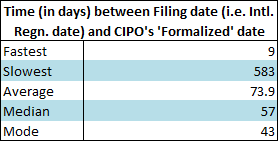If you do a “knock-out” search of CIPO’s online trademark database you should beware that a conflicting priority-claiming application for an identical mark could be filed up to six months after the date of your search. Canada’s accession to the Madrid Protocol presents a new issue: a conflicting priority-claiming Madrid “submarine” application for an identical mark could surface in CIPO’s database over 1½ years after the date of your search!
The term “submarine trademark” refers to the practice of concealing a new trademark by filing an initial trademark application in an obscure jurisdiction such as Mauritius having no searchable online trademark database, then filing priority-claiming applications in major countries shortly before expiry of the 6-month Convention deadline. In theory, the priority-claiming applications surface—like submarines—only after the trademark filing program is complete, thus thwarting squatters, copyists, etc.1
If you have worked with CIPO’s online trademark database, you may have noticed that the earliest Action History events that appear for a newly filed non-Madrid Canadian trademark application are the “Filed”, “Created” and “Formalized” events, as shown in the example on the right (click to enlarge the image). For a Madrid Protocol registration designating Canada, the earliest Action History events that you will see via CIPO’s online trademark database are the “Filed” and “International Registration” events, followed by the “Created” and “Formalized” events, as shown in the example on the right (click to enlarge the image).Madrid Protocol registrations designating Canada do not become available for public search purposes in CIPO’s online trademark database until CIPO takes the steps inherent in the “Created” and “Formalized” events. It is accordingly prudent to consider any potential time delay between the Filed / International Registration events and the Created / Formalized events in formulating caveats expressed in reporting search results, e.g. direct-hit knock-out searches performed via the online database.
In other words, how long does it take for a Madrid Protocol mark to work its way through the WIPO/CIPO systems and be made publicly available by CIPO? You can’t answer that question via CIPO’s online trademark database. To answer the question one must work with CIPO’s trademark .xml data.
As of 10-May-2021, CIPO had received 34,017 inbound Madrid filings. Utilizing CIPO’s trademark .xml data I have built a data warehouse containing details of all of those filings. Querying the data warehouse yields the following statistics2 for those 34,017 Madrid filings:
The “slowest” entry tabulated above corresponds to application no. 2099550 for which the Filed / International Registration event dates are 2019-09-09 and for which the Created / Formalized event dates are 2021-04-14, as shown on the right (click to enlarge the image). This means that there is a 583 day (19.3 month) gap between the Filing/IR and Created/Formalized dates. Moreover, the '550 application has a 08-March-2019 priority date. Accordingly, this is an example of a situation in which a hypothetical knock-out search of CIPO’s online trademark database conducted on, say, 01-Dec-2019, would have turned up nothing and yet a potentially identical mark entitled to priority over the searched mark could have appeared in the database well over a year after the date of the search.
The '550 application is not alone. Dozens of inbound Madrid filings exhibit a gap of over one year between the Filing/IR and Created/Formalized dates. Over 900 inbound Madrid filings have a gap of over 200 days (over 6 months) between the Filing/IR and Created/Formalized dates. Such gaps are of concern since many Madrid filings include a priority claim, potentially adding as much as 6 months to the gap within which rights may be impacted.
Irrespective of whether such gaps are due to delays inherent in WIPO’s systems, CIPO’s systems, or both; the fact is that the gaps are there, as shown in the following chart:
1 See “Submarine Trademarks”, WIPO Economic Research Working Paper No. 51, Amanda F. Myers et al, December 2018↩
2 The median is the middle value in a set of values. The mode is the value that occurs most often in a set of values.↩






